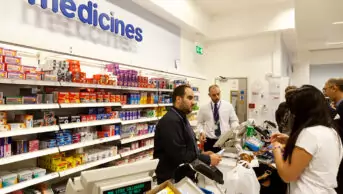
Charlotte Gurr / The Pharmaceutical Journal
The NHS drug budget is under unprecedented pressure. With new therapies emerging and demand surging, finding sustainable solutions is essential to long-term viability.
Currently, the NHS in England spends more than £19bn on medicines annually, with around half of this spend occurring in secondary care.
During the 2024/2025 financial year, the North East and North Cumbria (NENC) Integrated Care Board (ICB) spent more than £668m on medicines in secondary care, which is a figure that has increased by an average of 10% annually.
In March 2025, the NENC Provider Collaborative — a collaborative formed of 11 NHS trusts in the area — launched its medicines value programme, which I lead, in response to this growing challenge. Our goal is clear: to identify and implement medicines value initiatives that ensure sustainability, efficiency and equity across the region.
The programme was created to foster collaboration between each of the acute providers and commissioners, moving beyond traditional silos to create an open, constructive dialogue that supports shared solutions to challenges in medicines use.
Core to the successful and sustainable delivery of the programme is establishing collaboration over competition, which is an approach recently endorsed by Lord Darzi in his independent review of the NHS, published in September 2024. The NENC Provider Collaborative’s medicines value group was therefore formed, bringing together multidisciplinary stakeholders from pharmacy, medicines and finance to align under a collective strategy. By pooling our skills, knowledge and resources, we are building a strategic alliance committed to delivering best value from every pound spent on medicines.
Our approach and early achievements
1. Creating engagement: the medicines value group
Participation in the medicines value group is on a fully voluntary basis. We have been fortunate that experts and influential stakeholders have joined us in this shared purpose, as most of the work needs to be done from within the providers.
While a diverse portfolio helps manage uncertainty, ongoing vigilance and adaptability are essential
Group members meet once a month for an hour, with additional time invested in actions and initiatives agreed upon. The benefits realisation for this investment is through the support provided and the cost efficiencies achievable from the ICB block payments.
Creating a psychologically safe environment through building relationships and trust has been a priority to foster openness and innovation.
2. Building insight: the medicines efficiency tracker
One of our first actions was to develop a robust medicines efficiency tracker. This tool provides monthly insights into:
- Overall secondary care drug expenditure;
- Spend on tariff-excluded drugs;
- Costs associated with the ICB high-cost drug block;
- Spend/overspend on defined medicine value initiative indicators;
- Usage (i.e. defined daily doses/items) of defined medicine value initiative indicators.
Crucially, the tool allows us to compare current spending against the previous year, with transparent reporting at provider level. This isn’t about performance management — it’s about designing smarter service provision, allocating resources more effectively and evaluating the impact of our interventions.
We’ve also integrated agreed medicines value initiatives into the tracker, measuring them against efficiency targets and forecasting end-of-year performance. Already, we’re tracking £10m in planned efficiencies for 2025/2026, across the region’s eight NHS trusts.
3. Enhancing visibility: the high-cost drug dashboard
To deepen our understanding of prescribing patterns and patient outcomes, we developed a high-cost drug dashboard. Using pseudo-anonymised data submitted by trusts, we can analyse patient populations, prescribing pathways and outcomes, helping to ensure that the right patients get the right medicine at the right time.
For example, we have been able to address variations in the choice and frequency of ophthalmology injections.
4. Driving innovation: a shared cost improvement plan
For the first time in our region, acute providers have shared their medicine cost improvement plans. This level of transparency has fostered creativity, reduced duplication of work and enabled targeted support where it’s needed most. Our gap analysis has already identified significant untapped savings and aligned resources to deliver them.
We’ve also started running case study workshops — for example, we held a post-implementation review of the ustekinumab (Stelara; Janssen) biosimilar switch. Sharing lessons learned is preparing us to collectively seize the opportunities from upcoming biosimilar and generic switches.
Early results, published in April 2025, indicate that monthly spend on secondary care drugs is trending below the 2024 average.
What we have learned
1. Horizon scanning is crucial
Preparedness is essential. New drugs and indications, population growth, price changes and evergreening tactics all pose risks to our budget. While a diverse portfolio helps manage uncertainty, ongoing vigilance and adaptability are essential.
2. System thinking is essential
Although the programme primarily focuses on secondary care, we’re committed to a whole-system perspective. For example, work in secondary care on switching omeprazole liquid to dispersible tablets — which are more than 90% cheaper — has laid the foundation for scaling to primary care, where it could yield an additional £3m in savings.
3. Addressing variation and inequality
By benchmarking and identifying outliers, we can reduce unwarranted variation in patient care. This not only improves the quality and equity of treatments but ensures that finite resources are used where they have the most impact, supporting better access and outcomes across the population.
Looking ahead
As we move forward, the NENC Provider Collaborative’s medicines value programme will continue to evolve. Our commitment is to use data, collaboration and shared purpose to get the most value from the NHS medicines budget, ensuring we can meet rising demand without compromising on care quality or equity.
By working together, we can help to prevent the medicines bill from diverting vital funds away from other areas of patient care and ensure that innovation leads to better access, not just higher costs.
You may also be interested in

Lack of joined-up working between pharmacy and general practice is ‘nonsensical’, says former BMA chair

Pharmacy leaders warn of pressures on ‘exhausted, overworked’ pharmacists during longest doctors’ strike in NHS history
